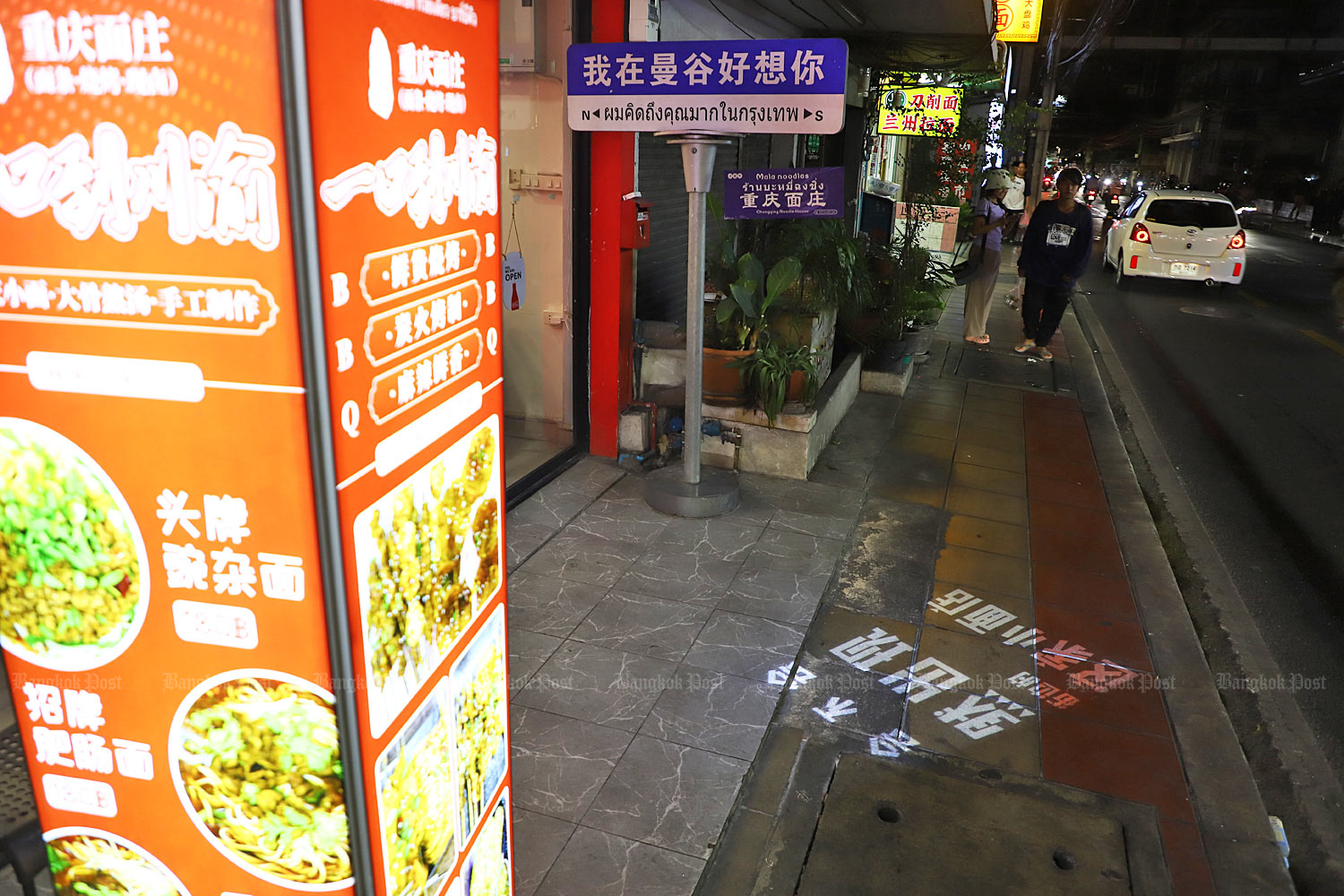A cluster of eateries and shops along Pracha Rat Bamphen Road in Huai Khwang, Bangkok, long dubbed the city’s second Chinatown, is reporting a noticeable drop in Chinese visitors as the market cools post–Songkran. While Thailand leans on tourism to power its economy under the “Amazing Thailand Grand Tourism and Sports Year 2025” banner, the sector has faced a series of headwinds that have slowed growth since the pandemic. Earlier this year, a high-profile safety scare involving a Chinese actor and subsequent concerns on Chinese social media further dampened sentiment, triggering caution among travelers and ripple effects across travel networks. Against this backdrop, the industry is watching risk factors such as canceled charter flights from China, a retreat in Chinese arrivals year over year, and broader global economic uncertainties tied to tariff policies in the United States. All of these dynamics are reshaping the trajectory of Thai tourism and prompting industry stakeholders to rethink marketing, pricing, and capacity strategies to sustain momentum through the upcoming peak seasons. The following sections unpack these interconnected threads in depth, outlining how safety concerns, policy shifts, and long-running dependence on the Chinese market interact with Thailand’s broader economic and tourism agenda.
Impacts on Bangkok’s Second Chinatown as Post-Songkran Slump Hits Chinese Visitors
The Pracha Rat Bamphen Road corridor in Huai Khwang—the area colloquially recognized as Bangkok’s second Chinatown—has long thrived on the vibrancy of Chinese visitors who fill its restaurants, markets, and entertainment venues. In recent weeks, business owners along this corridor have reported a clear downturn in foot traffic and consumer spend from Chinese travelers, a trend that aligns with broader caution in outbound travel from China and a softening Chinese consumer confidence. The post-Songkran lull is a critical inflection point because it tests the resilience of a district whose economic model leans heavily on the influx of Chinese guests. The downturn is not simply a matter of tourists choosing to stay away for a short period; it signals deeper questions about how quickly the market can rebound in a climate shaped by safety concerns, perception of risk, and the cost of travel in a global environment where many households calibrate discretionary expenditure to evolving macroeconomic signals.
For the owners and operators directly affected, the decline translates into slower revenue generation, tighter inventory management, and tighter labor planning. They must balance the need to maintain service quality with the imperative to conserve cash and optimize operating margins during a period of uncertain demand. This section will explore how such micro-level effects accumulate to influence the vitality of a district once celebrated for its bustling Chinese culinary and consumer experiences. We will examine how venue owners are reimagining their marketing approaches, adjusting price points, and recalibrating operating hours to align with shifting visitor patterns while maintaining the distinctive cultural and culinary appeal that defines the area. The broader implication is a potential reconfiguration of Bangkok’s cultural tourism map if the decline in Chinese visitors persists, prompting stakeholders to explore diversification strategies that broaden appeal to other regional and global audiences without diluting the authentic character of the district.
Government Tourism Drive in 2025 and the Slowdown Since the Pandemic
Thailand has been positioning tourism as a central engine of economic growth under the banner of the 2025 grand tourism and sports initiative. The government’s ambition is to harness the country’s natural and cultural assets to deliver a robust rebound from the pandemic-era shock and to establish a sustainable growth trajectory for the tourism economy. However, the current reality shows a mixed picture where optimism about policy-driven demand is tempered by persistent structural challenges. The past years have illustrated that a resilient tourism sector must navigate not only seasonality and demand volatility but also evolving consumer preferences, safety narratives, and geopolitical factors that influence travel decisions.
In this context, the 2025 campaign aims to multiply the country’s appeal across broader segments—sports tourism, cultural tourism, and long-haul markets—while leveraging digital marketing, streamlined visa policies, and strategic partnerships with international carriers and tour operators. Yet the sector’s slower growth since the pandemic reveals several frictions: lingering travel hesitancy among certain demographics, concerns about personal safety and scams, and the economic tradeoffs that families weigh when planning discretionary trips. This section analyzes how policy-level ambitions interact with real-world outcomes, including the alignment (or misalignment) between promotional messaging and traveler sentiment, the capacity of infrastructure and services to scale with demand, and the readiness of the industry to adapt to a changing travel ecosystem characterized by shifts in origin markets, route viability, and airline capacity.
A critical observation is that tourism policy alone cannot fully remediate market sensitivity to external shocks. The strategy must be complemented by targeted consumer reassurance, risk communication, and tangible safety assurances that restore confidence in Thailand as a secure, welcoming, and value-driven destination. It also requires collaboration across public and private sectors to address bottlenecks in visa processing, air connectivity, and ground services that influence the end-to-end travel experience. The effectiveness of the 2025 campaign will hinge on how well these elements are synchronized with real-time market signals, including visitor arrivals, average spend, length of stay, and the distribution of demand across regional and international markets. This section further explores how the campaign’s objectives can be realized through a disciplined, data-informed approach to marketing, product development, and service delivery that resonates with a broad spectrum of travelers, including Chinese tourists, who have historically represented a principal driver of economic activity in key areas such as Bangkok’s Chinatown clusters.
Safety Concerns and Their Ripple Effects on Tourism Sentiment
Safety concerns have emerged as a defining factor shaping sentiment in Thailand’s tourism sector, spreading through social media channels and influencing perceptions of risk among potential visitors. A high-profile case earlier this year—the kidnapping of a Chinese actor, Wang Xing, and his subsequent rescue from a scam centre near the Thai border in Myanmar—captured headlines and amplified anxiety across Chinese audiences. The incident, coupled with ongoing reports and discussions about trafficking and scam networks, has elevated travelers’ caution when considering trips to Thailand and the region. Although authorities and security agencies have taken steps to address vulnerabilities—such as enhancing call-centre scam deterrence and facilitating official visits and high-level diplomacy—the sustained attention to security matters has tempered enthusiasm for international travel and contributed to softened demand signals within the Chinese market.
In the wake of these events, chartered flights from China were reportedly canceled, and year-on-year Chinese tourist numbers have declined, marking a shift in travel patterns that ripple through the tourism ecosystem. The safety narrative has broader implications for related travel sectors, including airline operators, tour agencies, and hospitality providers, all of whom must adapt to fluctuating demand while maintaining service standards. The societal conversation around safety has extended beyond the immediate incidents to encompass perceptions of overall risk in travel to Southeast Asia, the reliability of local enforcement, and the responsiveness of the Thai government to safeguard visitors. All these factors interplay with consumer decision-making, influencing when and how travelers choose to visit the region, which in turn affects hospitality occupancies, dining patronage, and the broader economic contribution of inbound tourism.
Industry voices highlight that safety discourse remains an ongoing challenge, transcending isolated incidents to become part of the daily narrative through which prospective travelers assess risk. Despite governmental efforts to counter scams and reassure international travelers, the cumulative impact of safety concerns persists. Additionally, global economic headwinds—such as the interplay of tariff policies in the United States and broader macroeconomic uncertainty—compound these risk perceptions, prompting cautious spending and a preference for flexible itineraries and value-oriented travel options. The perception of safety is not merely a matter of incident occurrence but also of the credibility and timeliness of communications from authorities, the visibility of enforcement actions, and the consistency of travel advisories across the major source markets for Thai tourism.
A key takeaway from these dynamics is that safety considerations are a moving target that requires continuous monitoring, rapid response capabilities, and proactive storytelling to restore trust. Stakeholders point to several actionable steps: accelerating public-private collaboration to improve tourist policing and information channels, offering transparent updates about safety initiatives, and ensuring that travel guidelines evolve in step with changing risk assessments. In parallel, the sector must balance security messaging with positive narratives about Thailand’s tourist experiences, emphasizing safety-enhanced hospitality, reliable infrastructure, and the country’s capacity to deliver memorable visits. This nuanced approach is essential to avoid overstating risk while still acknowledging real concerns—an equilibrium that can help rebuild confidence among Chinese travelers and other nationalities who are weighing Thailand as a potential destination.
The Chinese Market: A Critical, Yet Volatile Driver of Thailand’s Economy
The Chinese market has long stood at the heart of Thailand’s tourism-driven economy, serving as a major engine of growth and a stabilizing force for international visitor inflows. The country’s appeal to Chinese travelers has a storied history that dates back to the early 2010s, a period marked by the box-office breakthrough of Lost In Thailand in 2012, which helped catalyze a broader wave of Chinese tourism to Thailand. Back then, Thailand hosted 22.3 million foreign visitors, of which 2.7 million—about 12%—were from China. This figure marked the beginning of a sustained growth trajectory, as inbound tourism expanded in the following years alongside other international arrivals. By 2019, Thailand reached a milestone with nearly 40 million tourists, including more than 10 million Chinese travelers, underscoring the Chinese market’s outsized role in driving the country’s tourism performance.
The onset of the pandemic delivered an acute shock to Thailand’s economy, highlighting the vulnerability associated with heavy reliance on tourism. China’s border closures and a slower post-pandemic reopening—especially in the real estate sector at home—slowed the recovery of consumer confidence and outbound travel demand from one of Thailand’s most important source markets. In the years since, the Thai government has pursued measures intended to re-engage Chinese travelers, including visa-free entry for Chinese tourists announced in late 2023. While this policy aimed to stimulate demand, actual arrivals landed at around 3.5 million Chinese visitors in that year, underscoring the challenges of a re-opened market in a climate of global uncertainties and evolving traveler behavior. The year 2023’s performance, with a forecast of 4-4.4 million Chinese arrivals, highlighted the gap between policy intentions and market realities, prompting ongoing adjustments in marketing and capacity planning.
Cultural narratives and media portrayals have also shaped sentiment around the Chinese market. The crime thriller No More Bets—reminiscent of human trafficking concerns—drew attention to potential dangers in Southeast Asia, influencing perceptions of safety among Chinese audiences. The film’s resonance in China, amplified by social media, revived discussions about trafficking and scams, thereby contributing to a cautious stance among potential travelers even as real-world conditions shift. The discourse around No More Bets intersected with concerns triggered by Wang Xing’s disappearance, illustrating how entertainment and criminal-justice narratives can converge to shape tourism sentiment. As such, tourism stakeholders must monitor these cultural signals and respond with clear, evidence-based communications that contextualize safety risks without amplifying fear or stigmatizing a broad group of travelers.
In 2024 and into 2025, the Thai travel ecosystem faced another layer of complexity: shifting flight capacity and the behavior of charter services. Some charter flights, especially those operating from second-tier Chinese cities, faced declining demand, while low-cost carriers adapted by reallocating capacity and adjusting pricing strategies. The outbound market from China has shown signs of rebalancing as Thai authorities and industry partners promote visa-free convenience as a value proposition, even as outbound demand to Thailand remains sensitive to macroeconomic conditions and exchange-rate dynamics. The broader implication is that while the Chinese market remains indispensable to Thailand’s tourism equation, its demand patterns can be highly elastic, responding to a constellation of factors including safety perceptions, tariff policy in key markets, and perceived affordability. The industry’s strategic response involves not only sustaining capacity on Thailand-China routes but also leaning into marketing that reinforces Thailand’s value proposition for Chinese travelers while pursuing diversification to other rich, nearby markets where growth potential remains robust.
Historical Context and Market Dynamics
A robust, multi-year growth story underpins the Chinese market’s centrality to Thailand. The late-2010s surge in Chinese tourist arrivals represented a shift in Thailand’s tourism base, reinforcing the importance of diversification across source markets but also spotlighting sensitivity to external shocks. The pandemic underscored the need for resilience and diversification, while policy measures such as visa facilitation and targeted marketing campaigns reflect ongoing efforts to reestablish momentum. The narrative around the Chinese market in Thailand now includes a complex mix of optimism driven by demographic scale and travel appetite, tempered by caution prompted by safety concerns, shifting global trade dynamics, and the evolving travel preferences of Chinese consumers who may prioritize domestic trips during periods of economic tightening or perceived domestic risk. The industry’s future success will depend on translating this mix of factors into concrete actions—enhanced safety assurances, improved connectivity, innovative product offerings, and a more agile, data-informed approach to promotions that can rapidly align with changing traveler sentiments.
Safety Fears, Airline Responses, and Industry Adjustments
Safety concerns have a cascading impact on airline planning, route viability, and pricing strategies, with carriers adapting to evolving demand signals and the broader risk environment. Vietjet Thailand, a key player in the Thailand-China air corridor, has reported a notable decline in Chinese passenger volumes—approximately 15-20% lower this year compared to the previous year. This trend is attributed to a combination of safety anxieties and a softer overall economy that affects travel budgets and willingness to commit to long trips. Chartered flights, which typically connect mid-sized Chinese cities to Thai destinations, have seen the largest reductions in demand, reflecting the sensitivity of secondary markets to perception and risk. The implications for carriers extend beyond immediate revenue pressures; carriers may also face longer-term capacity management challenges, including maintaining slots at major Chinese airports and ensuring operational flexibility to respond to shifting demand.
In response to reduced inbound demand, Vietjet Thailand has indicated a strategic pivot: maintaining capacity on Thailand-China flights to preserve slots, while pivoting marketing efforts to emphasize domestic tourism among Thai travelers as a primary audience for these routes. This approach aims to safeguard the airline’s network while capitalizing on the enduring appeal of Thailand’s tourism offerings to Thai residents who can act as a domestic tourism engine during periods of external-market softness. The shift reflects a broader industry strategy of leveraging domestic demand to stabilize revenue streams when cross-border travel faces headwinds. It also highlights a proactive stance toward preserving aviation infrastructure and market presence in anticipation of a potential rebound in international demand from China and other markets as confidence returns.
Other carriers have taken parallel steps by adjusting their route portfolios and pricing to mitigate revenue volatility. The Thai Travel Agents Association notes that many Chinese tour operators have relied on aggressive discounting to attract Thai tourists, highlighting a competitive dynamic in which lower airfares are used to stimulate demand for inbound visits despite unsold seats on the Chinese side. In some cases, Thai carriers have redirected capacity toward alternative destinations, such as Japan and India, to diversify away from heavy reliance on China while maintaining a flexible, resilient network. These adjustments underscore a practical recognition that the market environment remains complex, requiring operators to explore multiple levers—pricing, promotions, routing, and partnerships—to sustain activity and ensure continued access to popular Thai destinations for travelers from Asia and beyond.
Against this backdrop, industry observers note that the growth trajectory of inbound Chinese tourism this year does not appear as promising as the prior year. Yet there is a clear commitment to maintaining essential capacity on key Thailand-China corridors to safeguard long-term market access. The industry may rely on the higher-wind season in the final quarter as a potential source of upside, but achieving a return to previous levels of Chinese arrivals will require coordinated government and industry marketing efforts, as well as a restoration of consumer confidence. The potential for a rebound remains plausible given China’s large population, continued interest in Thailand’s rich tourist experiences, and the cross-border ties that bind the two economies. The central question remains whether the public sector and private partners can deliver a compelling, risk-balanced narrative that translates into tangible travel decisions, particularly for the crucial Chinese market that helps drive hotel occupancies, restaurant demand, and retail activity in Bangkok and other Thai destinations.
Workforce and Operational Considerations
From the perspective of labor and operations, the revenue instability associated with fluctuations in Chinese demand affects workforce planning in hotels, restaurants, travel agencies, and related services. Management teams are tasked with striking a balance between operational readiness and cost efficiency, ensuring that staffing levels align with forecasted occupancy without compromising guest service quality. In parallel, the industry is seeking ways to optimize the guest experience through targeted promotions, flexible booking policies, and enhanced safety assurances that can reassure travelers who may be weighing safety concerns against the value and novelty of a Thai travel experience. As the sector recalibrates, there is growing emphasis on leveraging data analytics to monitor demand patterns, adjust capacity more precisely, and tailor marketing messages to resonate with the evolving expectations of Chinese tourists and other international visitors. This strategic emphasis on operational agility and data-driven decision-making is essential to sustaining growth in a market characterized by high sensitivity to external shocks and dynamic shifts in traveler psychology.
Labour Day and Forward-Looking Marketing: Plans, Realities, and Prospects
To gauge near-term momentum, the Tourism Authority of Thailand (TAT) had anticipated a lift in Chinese visitor numbers in May, tied to the Labour Day holiday and a broader promotional push. The agency’s plan included leveraging traditional tourism marketing channels, expanding collaboration with tour operators to drive demand from second-tier Chinese cities, and expanding Thailand’s online presence to engage independent travelers. Executives emphasized a multi-pronged approach designed to stimulate both group tours and free-and-easy travelers who increasingly rely on digital research and booking platforms to shape their itineraries. The objective is to convert the Labour Day period into a meaningful inflection point—a signal that can validate the viability of the broader marketing framework for the second half of the year.
Nevertheless, the industry’s current reality—constrained forward bookings, cautious consumer sentiment, and the lingering impact of safety concerns—cast doubt on whether the Labour Day window would deliver a robust uptick. Observers noted that forward bookings for Labour Day remained relatively stable, with only modest improvements attributed to the extended holiday period. In the case of Vietjet Thailand, the pilot metrics around Labour Day suggested an average load factor for Chinese flights hovering around 85%, albeit with a substantial share of passengers being Thai rather than Chinese. This pattern indicates a shifting passenger mix and underscores the critical role of domestic demand in sustaining route viability during periods of subdued international demand. The airline’s network includes scheduled services to four major Chinese cities—Beijing, Shanghai, Hangzhou, and Guangzhou—alongside chartered services to several additional Chinese cities. The release of demand signals by travel agents in China appears subdued, with no new charter requests announced, raising questions about the timeline for a potential resurgence in the Chinese market.
Industry voices suggest that reaching or surpassing last year’s 6.7 million Chinese arrivals may prove challenging in the near term. In this context, the sector’s resilience depends on one or more catalysts: a tangible improvement in consumer confidence, a favorable policy environment that reduces travel friction, and renewed marketing momentum that successfully communicates Thailand’s unique value proposition across diverse Chinese demographics. The industry’s strategic imperative is to maximize the impact of the upcoming peak season by coordinating government campaigns with private-sector promotions, ensuring that marketing messages are culturally resonant, geographically targeted, and financially accessible for a wide range of travelers. The overarching belief among industry leaders is that the Chinese market remains a large and dynamic growth opportunity for Thailand, but its realization will require sustained, synchronized efforts from policymakers, airlines, travel firms, and hospitality providers, coupled with credible safety assurances that reassure potential visitors about the safety and value of a Thai travel experience.
Strategic Takeaways and Path Forward
The path forward involves a combination of demand-stimulating promotion, capacity management, and safety communications designed to rebuild traveler trust. Marketing strategies should emphasize Thailand’s rich experiences, diverse destinations, and the ease of travel through visa arrangements and streamlined processes, while also addressing concerns about safety and scams in a transparent and constructive manner. Airlines and tour operators can explore innovative bundles that pair culturally immersive experiences with flexible booking options, which can help accommodate households facing budgetary constraints and the volatility of recovery timelines. The industry should also consider diversifying source markets beyond China to reduce single-market dependency, all while maintaining a robust focus on Chinese travelers who remain a critical growth vector for Thailand’s economy. With the proper mix of policy support, industry collaboration, targeted messaging, and ongoing investment in safety and hospitality quality, Thailand’s tourism sector can better weather near-term headwinds and position itself for a durable rebound that supports the broader economic objectives of the country.
Conclusion
Thailand’s tourism sector stands at a crossroads where the resilience of its long-standing dependence on the Chinese market meets the immediate realities of safety concerns, global economic uncertainty, and post-pandemic recovery dynamics. The downturn in Chinese visitor numbers—whether driven by safety perceptions, economic pressures, or shifting travel preferences—has tangible implications for Bangkok’s second Chinatown and other tourism hubs across the country. While the government’s ambitious 2025 tourism and sports program signals a confident bet on tourism as a core economic driver, success will require a holistic approach that marries promotional vigor with credible safety assurances, enhanced connectivity, and adaptive capacity management. The safety narrative, highlighted by high-profile incidents and ongoing discussions about trafficking and scams, must be met with transparent communications, effective enforcement, and tangible improvements in visitor experience. At the same time, the industry should continue to pursue diversification, innovative marketing, and collaborations that can sustain momentum even when one market—such as China—experiences headwinds. As Thailand looks to capitalize on its visa-free arrangements, cultural richness, and hospitality strengths, the pace of recovery will hinge on how deftly policymakers and industry players translate risk signals into actionable strategies that restore confidence and translate into sustained growth across the Thai tourism ecosystem. The months ahead will test the sector’s ability to adapt, rebuild trust with Chinese travelers and other international visitors, and ultimately deliver the hoped-for rebound under the 2025 tourism framework.



